France & Maghreb
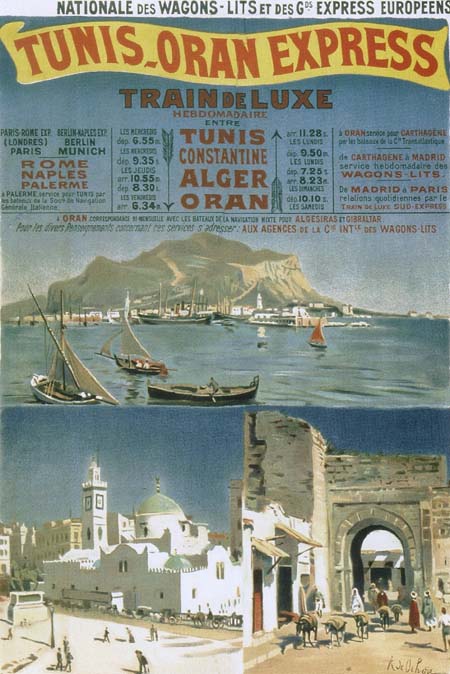 Connection with Navigazione Generale Italiana, CGT and Navigation Mixte, poster of 1901 by R. de Ochoay y Madrazo (coll. Juergen Klein)
Connection with Navigazione Generale Italiana, CGT and Navigation Mixte, poster of 1901 by R. de Ochoay y Madrazo (coll. Juergen Klein)
The first French steamers were state-owned and conveyed mail from the navy base Toulon. In 1829 Aynard Freres inaugurated regular steamer services from Toulon to Marseilles, to Naples and to Barcelona via Sete and in 1832 to Algiers with the "Scipion". In 1831 the Compagnie Generale, engaged in river traffic, started a service Arles - Marseilles. In the same year Charles & Auguste Bazin inaugurated a line Marseilles - Naples with the 120-ton "Henri IV" and "Sully". In 1841 the paddle-wheeler "Pharamond" shortened the traveling time between Marseilles and Algiers to 48 hours. The Government had tried to establish a monopoly for passenger services, but the Bazin brothers, Valery Freres of Corsica, Francois Fraissinet, Rostand and others broke it up (all information by Leonce Peillard).
Since state-owned French steamers Marseilles - Alexandria started services in 1837, the overland route through France formed the shortest connection England - India. For the official Indian Mail service via France, opened in 1839, initially British admiralty steamers Marseilles - Malta were used. It was the company Messageries Nationales, created already in 1798 for the conveyance of overland mail, which finally became the prominent French company for Mediterranean shipping, however not before 1851. In that year the company was awarded a mail contract and the Compagnie des Services Maritimes des Messageries Nationales, later Imperiales and finally Messageries Maritimes, was founded. They served also Algeria and for more than a century their black/white steamers maintained services from Marseilles to the eastern Mediterranean and beyond.
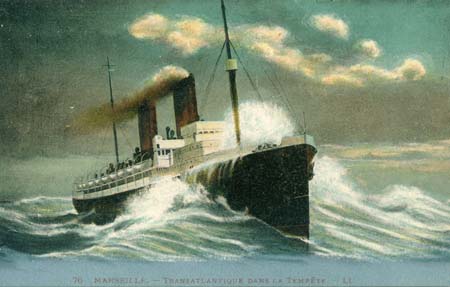 "Timgad" of CGT after departure from Marseilles (old card, coll. WS)
"Timgad" of CGT after departure from Marseilles (old card, coll. WS)
Another initiative was the foundation of the Compagnie Generale Maritime by Emile and Isaac Pereire in 1854, later the famous Compagnie Generale Transatlantique (CGT) . Before their steamers became dominating the French North Atlantic traffic, they provided more modest services, among others Marseilles - Antwerp. Marseilles got a rail connection with Paris in 1855. All over the 19th century the GGT was the prevailing company serving also the Mediterranean with mail lines from Marseilles and from Port Vendres to Algeria. The route between Oran in Algeria and Cartagena in Spain formed in 1902 a part of the round-trip Paris - Palermo - Tunis - Paris, offered in connection with a short-term Wagons-Lits de-luxe express Tunis - Oran. At the outbreak of WWI, the main routes were Marseilles - Algeria, Oran - Cartagena, Marseilles - Tunisia and Bizerte by CGT. Services were provided also by the Cie. de Navigation Mixte and by the Societe Generale de Transports Maritimes (SGTM) .
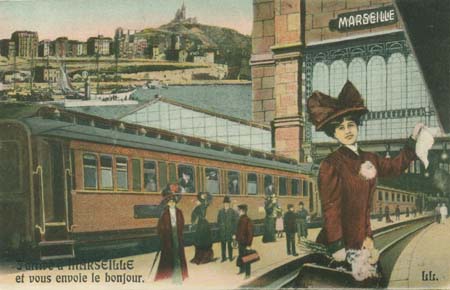
Marseilles, the port for the Maghreb (old card, coll. WS)
|
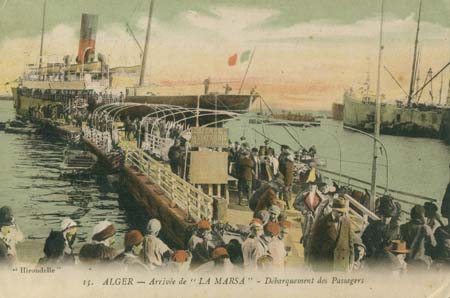
"La Marsa" at Algiers, before WWI (old card, coll. WS)
|
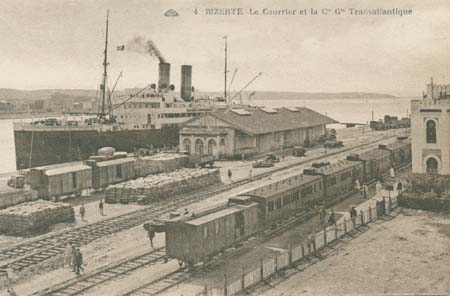
CGT steamer at Bizerte and train for Tunis (old card, coll. WS)
|
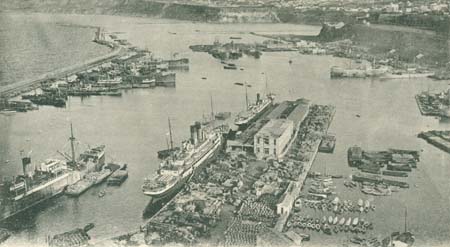
Oran between the wars (old card, coll. WS)
|
The Race to Algiers
Entering the Maghreb tourist business with a hotel chain and bus services, CGT offered in 1920 the first round trip Marseilles - Algeria - Morocco with the "Timgad". An attempt in favour of Port Vendres was started in 1926 by introducing a train from Paris connecting there with the Cie. de Navigation Mixte (CNM). Taking the "El Golea", passengers could cover the distance Paris - Algiers within 39 hours, with introduction of the "El Kantara" and "El Mansour" reduced to 36 hours. The Marseilles route responded with a direct "Train paquebot", which from 1933 until 1957 maintained at the mole La Joliette the connection with the ships to Algiers. With the "Ville d'Alger" and "Ville d'Oran" (1934/ 10,172 gt) the CGT reduced the total travelling time to 33 hours. Finally, in 1938, the 'Convention Mediterrannee' meant the end of the expensive race.
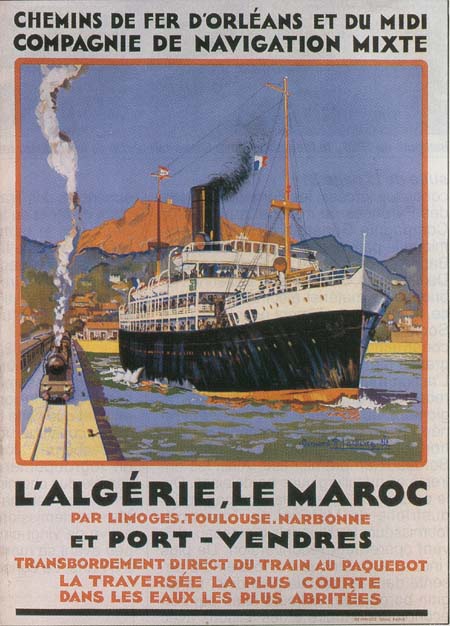
Cie. De Navigation Mixte at Port Vendres (advertisement)
|
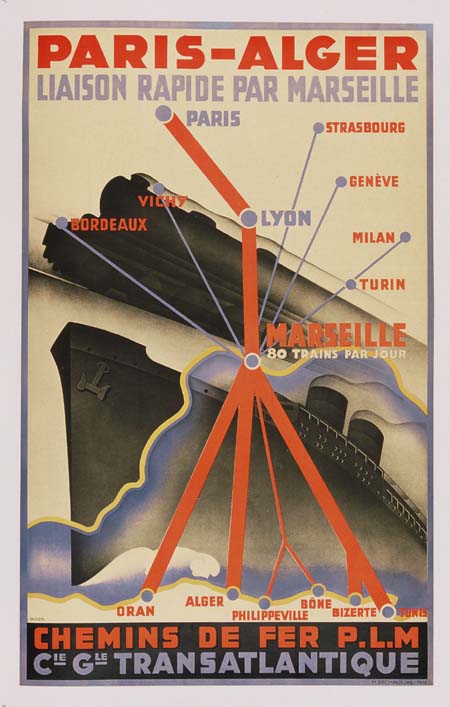
Cie Generale Transatlantique (coll. Juergen Klein)
|
World War II and Aftermath
During World War II, Mers-el-Kebir in Algeria became a name burning in the minds of Frenchmen, after three French battleships were sunk there by British bombers. After the Allies' victory, British troops were carried aboard refurbished passenger steamers to Toulon (and also to Naples and Taranto), where they boarded the 'Medloc' trains to Calais.
After WWII the CGT commissioned for Mediterranean services the steamers "Ville de Marseille" and "Ville de Tunis" (9,112 gt). The steamers of the CGT, Societe Generale des Transports Maritimes (SGTM) and the Cie. de Navigation Mixte kept up their services also during the Algerian War. CGT connected even Casablanca with their 6,687-ton motor-ship "Bordeaux". The Cie. de Navigation Paquet, a traditional steamship company, founded in 1863, linked Marseilles and Port Vendres with Casablanca. The project of a fast Morocco route by ship to Oran and from there by a special express to Casablanca was not realized due to hostile politics. In 1971 the Nouvelle Compagnie de Paquebots introduced the 10,513-ton car ferry "Massalia" on Canaries services. In 1975 the company bought the similar "Eagle" from Southern Ferries Ltd (P&O) and renamed her "Azur" (rebuilt into a cruise ship in 1981 and sold to Chandris in 1987, she survived until the 21st century as "Royal Iris" of Mano Maritime). The "Massalia" was employed at the end of the 70s by Paquet Cruises on a Marseilles - Casablanca - Dakar route, one of the longest distances ever covered by a car ferry. After the end of transatlantic services, the CGT became known as the Compagnie Generale Transmediterrannee and in 1976 it was re-organized as Societe Nationale Maritime Corse Mediterrannee or SNCM.
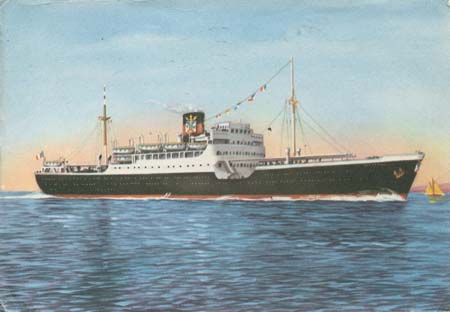
"Sidi-Mabrouk" of SGTM in the 50s (old card, coll. WS)
|
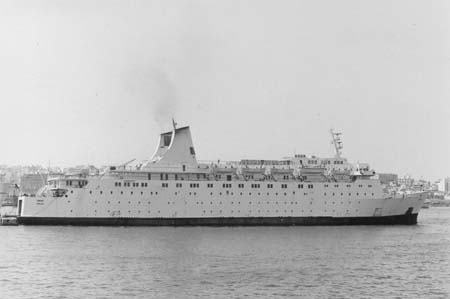
"Azur" of Nouvelle Cie. de Paquebots during a cruise, Piraeus 1977 (WS)
|
Tunisia
Tunisia achieved independence in 1956. Later the country had a remarkable growth in tourism. Car ferry services are provided by Cotunav (CTN) of Tunesia in marketing cooperation with SNCM. During years Cotunav chartered for summer season additionally the 38,261-ton "El. Venizelos" of ANEK as the largest ferry employed. Cotunav started also services to Italy.
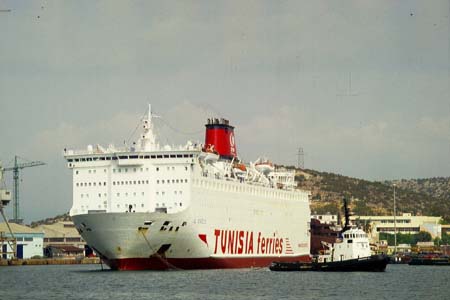
"El. Venizelos" after return to Perama, Greece, Oct. 2006 (WS)
|
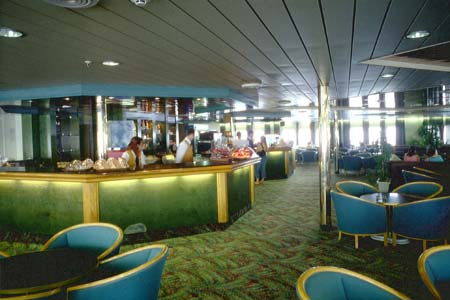
"El Venizelos", bar-lounge (WS)
|
Morocco
Morocco won independence from France and from Spain in 1956 and became a prospering kingdom. A car ferry service between Sete and Tangiers of Morocco was provided already in the 70s by the Cie. Marocaine de Navigation, employing the "Agadir" (the former "Vikingfjord" of 1969). Known as Comanav, the company replaced her in 1986 by the 11,515-ton newbuild "Marrakech". The enterprise is maintaining services to France, Spain and Italy. From 1984 also Comarit appeared with services to Spain, France and then to Italy, starting with second-hand vessels.
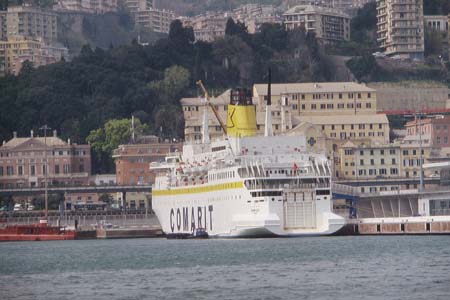 "Berkane" of Comarit, Genoa 2010 (WS)
"Berkane" of Comarit, Genoa 2010 (WS)
Algeria
Algeria, once known as 'La France Outre-Mer', achieved independence not before 1962. That country suffered for decades under stagnation and terrorists, harsh controls for immigrants were reported and tourists avoided Algiers. The Cie. de Navigation Mixte continued services and from the 70s the Cie. Nationale Algerienne de Navigation (CNAN) connected this country with car ferry routes from Marseilles to Algiers and from the Spanish port Alicante to Oran. French cooperating company was SNCM. In the new century services were continued by ENTMV, known as Algerie Ferries of Algeria. The "Millenium Express" (ex "Takachiho Maru", then "Millenium Express" of Access Ferries) of CNAN Maghreb Lines was temporarily employed by Transcoma on an Oran - Barcelona route. Now Algerie Ferries provides services Algeria - Marseilles in marketing cooperation with SNCM and also a service to Italy was added. In late 2011 the "Ariadne" of the Hellenic Seaways/ ANEK group, the former "Rainbow Bell" of Japan, could have been watched in Greece, sporting the label of Algerie Ferries, which had leased the ship.
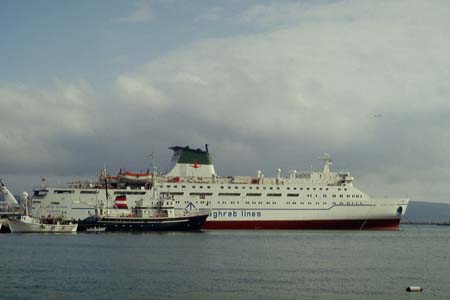
"Millenium Express" of CNAN Maghreb Lines, Lavrion, Greece 2006 (WS)
|
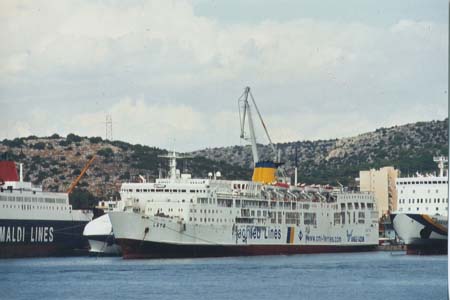
"Lato" (ex "Daisetsu") of ANEK, after operating for Maghreb Lines, Perama 2007 (WS)
|
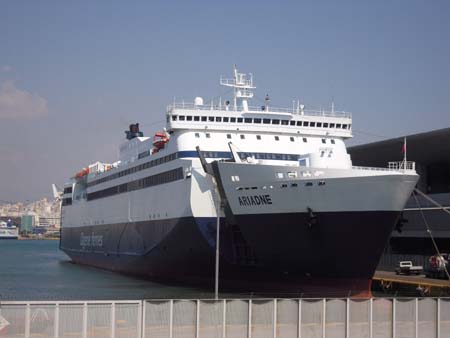
"Ariadne" (ex "Rainbow Bell", "Ferry Hinuka") of ANEK/ HSW, ops by Algerie Ferries, transferred to Piraeus, Oct. 2011 (WS)
|
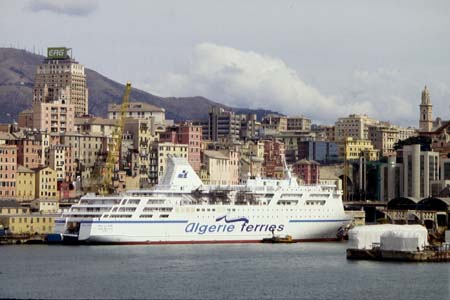
"Tariq Ibn Ziyad" of Algerie Ferries, Genoa 2009 (WS)
|
Corsica Island
Corsica Island of France was always tightly connected with the mainland. Before WWI services from Marseilles were provided by Fraissinet & Co. and by CGT. Connection Paris - Marseilles was provided by the Paris-Lyon-Mediterrannee railway. Nice, the fashionable Cote d'Azur resort, was the secondary port of embarkation. On the mountainous island of Corfu a rail network was opened, beginning in 1888 at Bastia. From 1933 Fraissinet made connection at the harbours Ajaccio and Bastia with metre-gauge "trains-paquebots". In the 1950s CGT was the market leader. A strikingly modern Corsica car ferry, the "Fred Scamaroni" of CGT, was built in 1966.
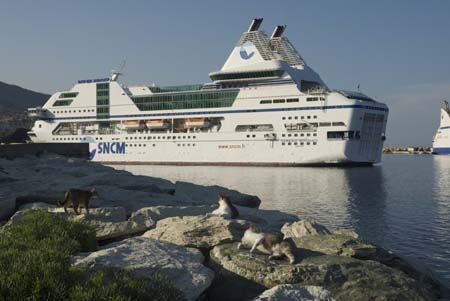 "Napoleon Bonaparte" at Bastia, Corsica, 2007 (Klaus von Halem)
"Napoleon Bonaparte" at Bastia, Corsica, 2007 (Klaus von Halem)
State-owned SNCM, a daughter of CGM and state railways SNCF, took over the services. In 1989 SNCM introduced the comfortable 30,985-ton "Danielle Casanova" and in 1996 the "Napoleon Bonaparte" as their largest ferry. That colossal 44,300-ton ferry appeared on the routes from Marseilles to Corsica and Sardinia. But racy hi-speeds were commissioned, too. Already in 1994, after Leroux et Lotz had delivered their "Corsaire 6000" to Emeraude Lines, SNCM decided for this innovative monohull hi-speed type. After the Corsaire 11000 type 4,934-ton "NGV Asco" and "NGV Aliso" were sold to Greece, the "NGV Liamone" of the Corsaire 13000 type (9,351 gt, 250 cars, 42 knots) remained on the Corsica route. In 2005 investors offered to purchase subsidized SNCM, but the way of the planned privatization "caused a public outcry" (as reported by Wikipedia) and a political scandal. In 2006 participation by another partner, Veolia Transport, was carried out. In 2007 the "Superfast X" entered Corsica services of SNCM as "Jean Nicoli", but then she was transferred to Sea France. In 2009 another "Jean Nicoli", the former "Pasiphae Palace" of Minoan Lines, was acquired. In 2011 Lloyd's List reported that SNCM was to lose the Corsica contract.

Corsaire 11000 type for SNCM Ferryterranee (official picture)
|
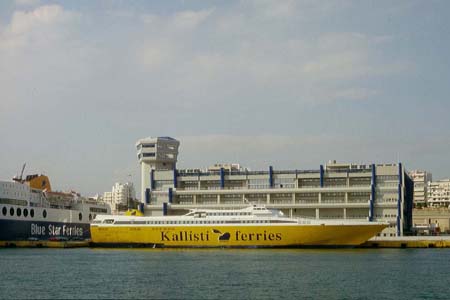
"Corsica Express Three", temporarily operated by a Greek subsidiary, Piraeus 2007 (WS)
|
In 1967 the "Corsica Express", ex "Kronprins Olav" of DFDS, opened the car ferry service of Corsica Ferries. Extended Corsica & Sardinia Ferries introduced the yellow/white car-carrying 2,500-ton hi-speed monohulls "Corsica Express II", III and "Sardinia Express" of the Aquastrada type, developed by Rodriquez of Sicily. Built in 1996 for a speed of 37 knots, they took for the Nice-Bastia passage over 124 nm only 3 1/2 hours, operating under Italian flag. Then the company extended its second-hand fleet.
CNM or La Meridionale, operating from Marseilles, turned away from hi-speed and took over in 2002 the 28,417-ton "Aretousa" from Minoan, introducing her as their largest ferry "Girolata" on Marseilles - Corsica and Sardinia services. In 2009 French labour unions combated the plan of SNCM and Meridionale to set up a subsidiary for developing new Mediterranean lines and in 2011 SNCF was hit by strike. For the same year the largest newbuild of 41,700 gt had been commissioned.
|